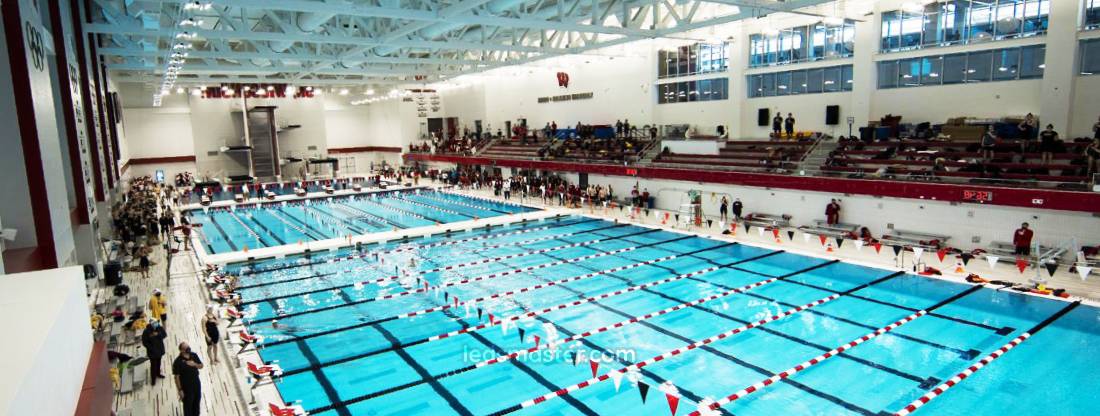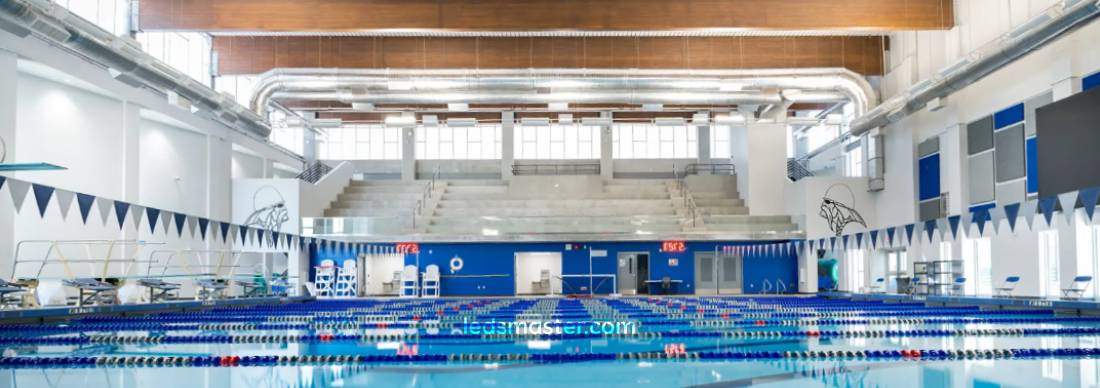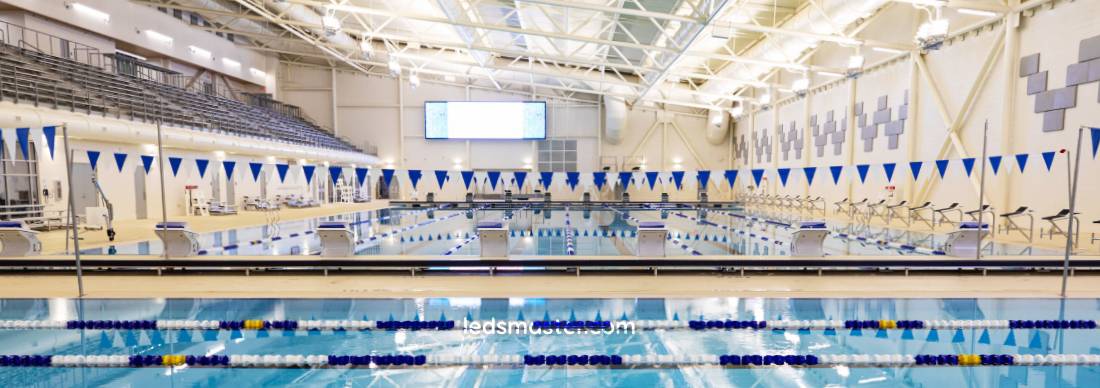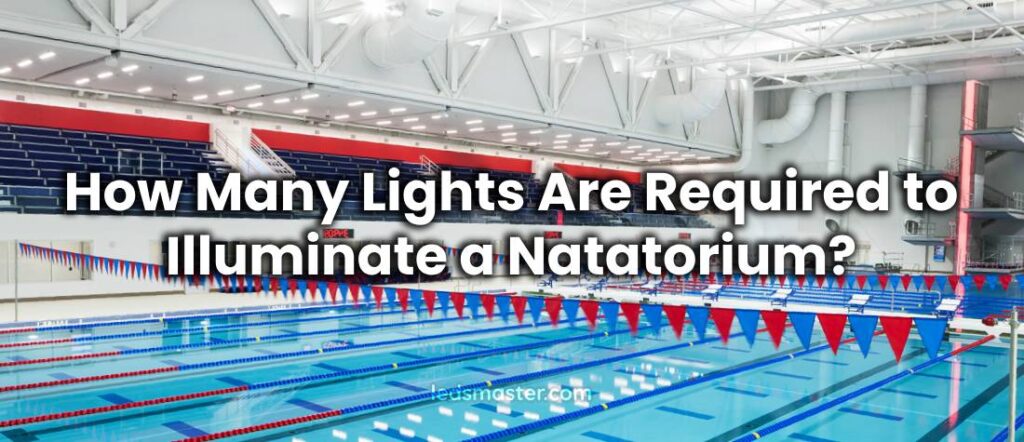Designing an effective lighting system for a natatorium isn’t just about picking bright fixtures, it’s about aligning the number and placement of lights with the pool’s unique characteristics and usage. Several critical factors come into play, from the level of competition hosted to the ceiling height, surface finishes, and pool dimensions. Each element contributes to how much light is needed and how it should be distributed to ensure safety, clarity, and comfort for everyone in the facility.
Table of Contents
ToggleFactors Affecting the Number of Lights
Level of Competitions Hosted
The level of competition hosted in a natatorium has a strong influence on the lighting layout and intensity. Facilities designed for recreational swimming or general fitness do not require the same lighting rigor as those certified for professional competitions. For example, leisure pools may aim for functional visibility, while Olympic-standard pools demand precise, high-lumen fixtures that can deliver consistent illumination across all lanes.
Competitive events require enhanced lighting for clarity, fairness, and safety. In national and international contests, lighting is expected to meet specific lux levels, uniformity ratios, and color rendering indexes (CRI) dictated by governing bodies like FINA or NCAA. These specifications ensure that swimmers are clearly visible at all times, both to spectators and to judges responsible for enforcing race regulations. Televised events add further complexity, as lighting must eliminate shadows and balance brightness for HD camera capture.
The higher the prestige and technicality of the event, the more demanding the lighting setup becomes. Pools hosting frequent championship meets must often invest in more advanced fixtures, customized mounting strategies, and real-time lighting control systems to accommodate varying needs throughout the season.

Height of the Ceiling
The ceiling height in a natatorium plays a major role in determining how many light fixtures are required and how they should be positioned. Higher ceilings increase the distance between the light source and the water surface, which can result in diminished brightness unless adjustments are made in fixture selection or quantity. In these cases, high-wattage LED fixtures or beam angle modifications may be needed to maintain adequate illumination.
In contrast, lower ceilings enable better proximity to the target area but can introduce challenges such as glare and harsh reflections if not properly managed. Low-hanging lights must be carefully aimed and diffused to avoid interfering with swimmers’ vision and to maintain an aesthetically pleasant environment. The mounting height directly affects light spread (beam width), which can either optimize or compromise overall efficiency depending on how it’s planned.
Additionally, facilities with elevated architectural elements like skylights, trusses, or ventilation ducts may need custom brackets or specialized light distribution patterns. Ceiling height isn’t just a structural detail—it fundamentally shapes the entire lighting layout.
Surface Area of the Swimming Pool
The most immediate and calculable factor that influences how many lights a natatorium needs is the total surface area of the pool. Larger pools cover a wider footprint and thus demand more comprehensive lighting solutions to ensure full coverage without dark spots. Lighting a standard Olympic-size pool (50 meters by 25 meters) is a vastly different task compared to a small hotel lap pool.
Even lighting distribution across both the length and width of the pool is vital to avoid visual inconsistencies that could distract swimmers or obscure underwater lane markings. The longer the pool, the more linear the lighting configuration becomes, often requiring parallel rows of fixtures spaced evenly along the structure. Wider pools may necessitate additional rows or side-angle lighting to reach outer edges.
Pools with irregular shapes—such as those with diving wells, splash zones, or attached therapy sections—may require bespoke lighting solutions that break from uniform layouts. Overlapping beams are frequently used in large venues to ensure redundant coverage and to maintain high levels of visual consistency across all points.
Reflective Qualities and Interior Finishes
The materials and colors used on the walls, ceilings, and even the pool lining can drastically affect how much light is needed. Spaces with light-colored, glossy, or tiled finishes reflect more light throughout the environment, enhancing perceived brightness without having to install more fixtures. White ceilings, polished ceramic tiles, and glass walls can help distribute light evenly, reducing energy demands.
Conversely, darker or matte finishes absorb more light and reduce internal reflection. If a natatorium is designed with deep blue tiles, exposed concrete walls, or dark-painted ceilings for aesthetic or practical reasons, more lighting power may be required to overcome the natural light absorption of these materials.
The reflectivity of the water surface also plays a part. Still, clean water acts as a mirror, increasing ambient light, while turbulent or chemically treated water can scatter or diffuse light differently. Even surface finishes around the deck—such as anti-slip tiles or vinyl—can impact how light bounces through the environment.
Therefore, interior design choices are not purely decorative—they intersect directly with lighting performance and fixture planning. Careful material selection can either reduce or increase lighting costs and fixture requirements.
Appropriate Number of Lights and Pool Safety
Visual Comfort for Swimmers and Spectators
The visual experience inside a natatorium greatly depends on the distribution and intensity of its lighting. Swimmers require consistent, balanced illumination to navigate the water safely. Shadows cast across lanes or patches of excessive brightness near the water’s edge can interrupt a swimmer’s rhythm, affect lap timing, or contribute to disorientation—especially during flip turns and underwater phases of a race.
Lane markers, backstroke flags, pool edges, and depth markings must remain clearly visible at all times, and any inconsistency in lighting can compromise this visibility. This becomes even more relevant when underwater lighting is used in tandem with overhead fixtures, requiring coordination to avoid color mismatches and intensity disparities.
From a coaching and safety standpoint, consistent lighting is also beneficial. Lifeguards and trainers must maintain full visibility of every corner of the pool, including less active zones like diving wells or shallow areas. Poorly illuminated sections increase the risk of unnoticed incidents or delayed emergency response.
Spectators attending competitive events benefit as well. Uniform lighting enhances the clarity of fast-moving action, allows for better viewing angles, and minimizes strain during long events. Well-lit seating areas and unobstructed lines of sight also contribute to an enjoyable viewing experience.
Minimizing Glare and Shadow Zones
One of the recurring challenges in natatorium lighting design is the control of glare and shadows. Water reflects and refracts light in unpredictable ways, which can result in visual discomfort for both swimmers and viewers if lighting is not carefully planned.
Overhead lights positioned too directly above the pool may create intense glare on the water’s surface. Improperly angled fixtures can lead to deep shadow zones, especially at the bottom of the pool or along wall intersections. This not only disrupts aesthetics but can present safety concerns for swimmers who rely on visual cues to orient themselves.
Solutions often involve a combination of asymmetrical lighting layouts, cross-lighting strategies, and glare-resistant fixture optics. Using wide-beam LEDs with frosted diffusers or specialized lensing systems can help spread light more evenly while avoiding overly intense reflections. Fixture mounting height and tilt angle are also fine-tuned during the design process to balance brightness and minimize discomfort.
When glare is properly mitigated, swimmers enjoy better visual comfort, lifeguards can maintain uninterrupted surveillance, and the architectural appeal of the space is preserved. Every reduction in glare and shadow improves both functionality and the overall experience inside the facility.
Emergency and Safety Lighting Considerations
Beyond routine use, lighting systems in natatoriums must be engineered to support emergency situations, power outages, and evacuation scenarios. The primary lighting grid is typically backed up by a series of emergency fixtures connected to battery systems or generators.
These emergency lights are positioned to provide immediate, clear visibility of the pool, exit routes, and gathering points. Even though the quantity of emergency fixtures is lower compared to the main lighting system, their design ensures wide-angle coverage to prevent any part of the natatorium from becoming dangerously dark.
In facilities with large swimming areas or multiple zones, dedicated emergency lights are installed along stairways, entrance and exit corridors, locker room passages, and first aid stations. Their illumination levels must meet minimum lux requirements outlined by safety standards, such as those from the International Building Code or local regulations.
Some modern natatoriums also incorporate automatic testing systems for emergency lights that run diagnostics on battery life and fixture operation at regular intervals. This ensures compliance and prepares the system for sudden use, eliminating the risk of unlit exits during an outage.
Ultimately, a reliable emergency lighting strategy reinforces the overall safety framework of the natatorium. It guarantees that swimmers can exit the pool quickly, staff can respond without hesitation, and visitors can move to safety without confusion or injury, even under reduced visibility conditions.

Lighting Uniformity and Standards
Recommended Lux Levels by Activity
| Pool Type | Lux Level Range | Purpose |
|---|---|---|
| Recreational Pools | 200–300 lux | Casual swimming and public use |
| Training Pools | 400–600 lux | Technique analysis and coaching |
| Competitive Events | 800+ lux | Swimming competitions and water polo |
| International/Broadcasted Events | 1000+ lux | High-speed cameras and broadcast clarity |
Lux levels serve as the standard measure for how much light illuminates a surface, and the appropriate levels vary based on the nature of pool use. Recreational pools generally operate within the 200 to 300 lux range, which is adequate for casual swimming and public use without the demand for technical visibility. However, training pools often require higher illumination levels—typically between 400 and 600 lux—to enable coaches to assess stroke mechanics, body positioning, and technique with precision.
For competitive events, the requirements rise substantially. Swimming competitions, water polo matches, and synchronized swimming events often call for 800 lux or more, depending on the scale and governing standards. International-level events, especially those broadcast on television, may demand 1000 lux or greater to support high-speed cameras, enhance athlete visibility, and eliminate shadow zones.
Achieving these elevated lux levels uniformly across both the water and deck surfaces can be technically complex. Lighting must avoid bright hotspots or underlit areas that can impact visual comfort and swimmer orientation. Uniformity, more than just brightness, defines lighting quality in a natatorium.
Color Rendering Index (CRI) for Visual Clarity
While lux measures quantity of light, CRI—Color Rendering Index—assesses the quality. A CRI above 80 is considered optimal for aquatic environments, where color differentiation can affect performance, safety, and visual cues. Markings on the pool bottom, lane ropes, warning flags, and team uniforms must be easy to distinguish under artificial lighting.
Poor CRI can distort colors, making it harder for athletes and officials to interpret their surroundings. In competitive settings, this can lead to timing errors, misread signals, or hindered performance. Additionally, a high CRI contributes to the visual sharpness required for televised coverage, offering crisp contrast and realistic hues for broadcast audiences.
From an architectural perspective, a high CRI improves the interior ambiance by allowing painted surfaces, banners, and branding elements to appear more vibrant and appealing, supporting both functionality and aesthetics.
Uniform Distribution and Fixture Placement
Beyond lux and CRI, uniformity in light distribution determines the usability of the space. Fixtures must be arranged to ensure that no zone within the pool receives disproportionately high or low levels of light. Uneven lighting creates glare zones and dim pockets that impair spatial orientation and depth perception.
A well-designed fixture layout includes overlapping light cones to balance brightness while avoiding excessive direct exposure to the water’s surface. This balance is vital for events where swimmers rely on consistent visual input to guide their strokes, turns, and starts.
Obstacles such as ceiling beams, ventilation ducts, and architectural overhangs must be factored into fixture placement to avoid light interference and maintain a smooth gradient of brightness across all surfaces. The angling of fixtures, especially when mounted on high ceilings, requires precise calculation to eliminate glare while ensuring even floor coverage.

Energy Efficiency and Fixture Types
LED Fixtures and Operational Savings
LED lighting continues to gain preference in modern natatoriums due to its operational efficiency and cost advantages. LEDs convert a greater percentage of electricity into visible light, reducing wasted energy in the form of heat. This performance translates to a lower power requirement for achieving the same lux output compared to traditional technologies such as metal halide or fluorescent fixtures.
With longer lifespans—often exceeding 50,000 hours—and stable light output over time, LED fixtures reduce the frequency and cost of replacements. These savings are particularly valuable in aquatic centers, where accessing ceiling-mounted lights for maintenance can involve scaffolding, lifts, and service downtime.
Another benefit is the lack of warm-up delay. LEDs reach full brightness instantly, which makes them compatible with motion sensors, smart controls, and emergency lighting schemes. Their responsiveness adds to overall operational flexibility.
Smart Controls and Adaptive Lighting
Many facilities now integrate smart lighting systems with sensors, timers, and automated control logic. These systems allow lighting to adjust in real-time based on occupancy, scheduled events, or natural light levels streaming through windows or skylights.
For example, during early morning hours or setup time, lights can operate at 30–50% capacity. Brightness can increase automatically during competitions or high-traffic periods, optimizing energy usage while maintaining appropriate visibility. Some systems even allow staff to control lighting remotely via mobile applications or digital interfaces.
By tailoring light output to actual needs rather than fixed schedules, adaptive lighting significantly reduces electricity usage. It also helps extend the lifespan of fixtures by reducing the hours they operate at maximum output, offering both sustainability and financial benefits.
Maintenance and Durability Considerations
Natatoriums present unique environmental challenges for lighting systems. The air contains elevated levels of humidity and chlorine, both of which can corrode or degrade electrical components over time. Fixtures must be sealed to withstand moisture ingress and built from corrosion-resistant materials like stainless steel or coated aluminum.
LED systems, with their low heat output and sealed construction, are generally better suited for these conditions. Fewer moving parts and no reliance on ballasts or fragile tubes reduce the likelihood of failure. Maintenance is limited to periodic cleaning of lenses or protective covers to remove water spots, dust, and condensation film.
Facilities with high-mounted lights may also opt for systems that include tilt or hinge mechanisms, allowing fixtures to be lowered safely for maintenance. This reduces downtime and labor costs associated with replacing or adjusting equipment located far above the pool.
In short, choosing lighting systems with durability and ease of maintenance in mind strengthens the long-term viability of the installation and ensures safe, uninterrupted operation for swimmers, coaches, and spectators alike.

Budgeting and Project Planning
Initial Installation Costs
Lighting systems in a natatorium represent a major capital investment, and the number of lights required directly impacts the initial budget. Installation costs include not only the fixtures but also mounting brackets, conduits, junction boxes, dimmers, and control interfaces. For large facilities or those with unique ceiling structures, custom lighting configurations may be required, raising both material and labor costs. Ceiling height, surface reflectivity, and pool dimensions all influence fixture wattage and quantity.
Retrofitting an existing facility can add to the complexity. Older buildings may require upgrades to electrical infrastructure or reinforcement of mounting surfaces. Detailed photometric studies and professional lighting plans are typically necessary to comply with performance and safety standards. These upfront services should be included in the budgeting phase to avoid unexpected expenses.
Operational Expenses Over Time
Beyond installation, lighting systems contribute significantly to a natatorium’s recurring costs. LED systems offer reduced power consumption—often cutting energy use in half compared to legacy technologies. They also demand less frequent maintenance, due to their longer service life and durability.
Energy use is calculated by evaluating the total wattage of installed fixtures against hours of operation and facility size. Efficient lighting systems lower electricity bills and reduce greenhouse gas emissions, aligning with sustainability goals. In some cases, facilities equipped with advanced lighting can reallocate operational savings toward programming, staffing, or other upgrades.
A thorough cost-benefit analysis often reveals that while modern lighting systems have higher up-front costs, they become more economical over a 5- to 10-year lifecycle. Factoring in utility rebates and tax incentives can further accelerate this return on investment.
Compliance with Local Codes and Incentives
Lighting plans must align with local building and safety codes. Municipalities often stipulate minimum lux levels for aquatic centers, particularly those open to the public. Other regulations may address energy efficiency, emergency lighting, and accessibility.
To streamline the permitting process, facilities may need to provide photometric reports and product data sheets demonstrating compliance. Working with a certified lighting designer or electrical engineer helps ensure these requirements are met.
In some regions, financial incentives are available for lighting upgrades. Programs from local utilities or environmental agencies may offer rebates for switching to LEDs or installing smart controls. These incentives can reduce upfront costs and support broader sustainability initiatives. Including such options in the planning process not only improves affordability but may also unlock public or private funding opportunities.

Designing with Purpose for Long-Term Success
Lighting in a natatorium is more than just a functional necessity—it shapes how the space is experienced by swimmers, coaches, spectators, and maintenance staff alike. When designed thoughtfully, it enhances visibility, supports safety, and promotes efficient facility operations. Matching lighting solutions to the unique character and purpose of each pool space helps optimize both performance and cost-effectiveness. Emphasizing visual comfort, fixture durability, and system adaptability ensures that the lighting not only meets present needs but can evolve alongside the facility’s growth. Whether updating a legacy structure or designing a new aquatic center from the ground up, integrating lighting into the broader planning framework yields a more coherent and enduring result. The right combination of uniform illumination, efficient technology, and architectural synergy will continue to provide value across years of use and a wide spectrum of aquatic activities.
Conclusion
A natatorium is more than just a place for swimming; it’s a place where athletes train, children learn, communities gather, and performances unfold. Proper lighting creates an environment that supports all of these experiences. When done right, it allows swimmers to perform at their best, lifeguards to see every corner of the water clearly, and spectators to enjoy a visually comfortable view. Lighting also contributes to the atmosphere, making the facility more welcoming, professional, or high-energy depending on the desired mood. By considering all the variables that influence fixture selection and placement—such as pool dimensions, ceiling height, reflectivity, and usage scenarios—it becomes possible to build a system that delivers optimal results. As technologies continue to advance and design approaches evolve, natatorium lighting stands to become more adaptive, efficient, and performance-oriented, creating better environments for everyone who enters the space.

